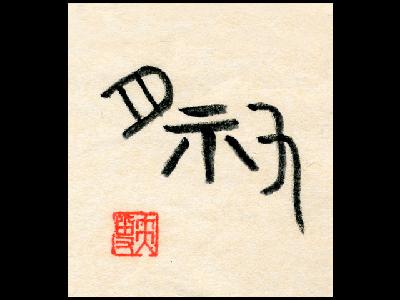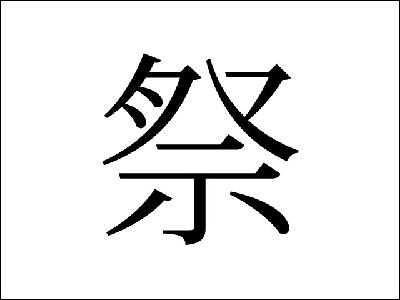【祭】 Sai, Matsuri Festival
|
Presently, as in the usage ‘matsuri: sale,’ the character 祭 ‘matsuri: feast, festival, festivity’ has come to be used also apart from the original religious context. Compared with the ancient usage, its meaning became slightly shallow.
The character 祭 originally depicts a scene of worship of ancestors’ souls in the mausoleum. The 又 at the right above is a hand, the part 月 at the left above is the meat offered, and 示 below is an altar, thus it shows the part of a ritual of offering worship meat on an altar with the hands. By adding the宀 roof classifier showing the roof of a mausoleum it gets 察 ‘satsu: guess,’ which originally means to inquire the divine will. The 阝 of 際 being a ladder for the gods, when conducting this ritual of presenting offerings, as result the gods descend. The tortoise plastron and bone character form being the starting point of 祭 does not have the element 示, which was added later in the bronze inscriptions. As the original character form of 禮 also has no 示 classifier in the early stages of Kanji development, it can well be understood that the number of character strokes is small on the tortoise plastron characters compared with the forms of later times due to the hard nature of the medium. As also could be seen in the case of 師, the custom of offering meat to worship the ancestors exists since old times. The dots at the part showing the meat in the above tortoise plastron character form represent drops of blood.
The character 祭 originally depicts a scene of worship of ancestors’ souls in the mausoleum. The 又 at the right above is a hand, the part 月 at the left above is the meat offered, and 示 below is an altar, thus it shows the part of a ritual of offering worship meat on an altar with the hands. By adding the宀 roof classifier showing the roof of a mausoleum it gets 察 ‘satsu: guess,’ which originally means to inquire the divine will. The 阝 of 際 being a ladder for the gods, when conducting this ritual of presenting offerings, as result the gods descend. The tortoise plastron and bone character form being the starting point of 祭 does not have the element 示, which was added later in the bronze inscriptions. As the original character form of 禮 also has no 示 classifier in the early stages of Kanji development, it can well be understood that the number of character strokes is small on the tortoise plastron characters compared with the forms of later times due to the hard nature of the medium. As also could be seen in the case of 師, the custom of offering meat to worship the ancestors exists since old times. The dots at the part showing the meat in the above tortoise plastron character form represent drops of blood.
- name
- Editoral supervision: Dr. Christoph Schmitz, Researcher of Shirakawa Kanji Science, General and Japanese History of Philosophy and Thought
- hp
- http://nippon-kichi.jp/article_list.do?p=5332














